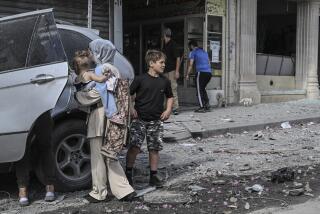Parsing the rules of war
- Share via
Shortly after 8 p.m. on May 4, American B-1 bombers began pounding the Afghan village of Granai in an effort to protect a group of Afghan soldiers who had come under fire. When the airstrikes ended seven hours later, somewhere between 26 and 140 Afghan civilians were dead (depending on whose figures you believe). The casualties added fuel to an anguished debate about civilian deaths in wartime that has raged since the war in Afghanistan began -- and for hundreds of years before that. Below, some questions and answers on the rules of war.
How many civilians are being killed in Afghanistan?
The Brookings Institution concludes in its “Afghanistan Index” that more than 5,000 civilians have died in the war between 2006 and the first half of 2009. Nearly 2,000 of the deaths are attributed to pro-government forces, including the U.S., other international forces and the Afghan army.
How do those numbers compare with other conflicts?
Frankly, they’re low. In the same period in Iraq, for instance, more than 60,000 civilians were killed (as a result of military actions by all the parties in the conflict), according to Brookings.
Certainly, the number of civilians who have died in Afghanistan is tiny compared with the number in previous conflicts the U.S. has been involved in. Civilian deaths during the Vietnam War, for instance, were estimated to be in the millions, helped along by such atrocities as the massacre of between 300 and 500 villagers by U.S. soldiers in My Lai in 1968, and by carpet bombings of the countryside that indiscriminately killed whoever was below.
In World War II, nearly 40 million noncombatants were killed, according to historian Niall Ferguson, thanks, among other things, to the mass starvation tactics adopted by the Germans on the Eastern Front, the devastating firebombing by the Allies of Japanese and German cities and the bombs dropped at Hiroshima and Nagasaki in August 1945. World War I killed more than 6 million noncombatants, by most estimates, and about 50,000 civilians died in the Civil War, according to historian James McPherson.
Why so many fewer this time?
War is different today. Precision weapons -- smart bombs, Predator drones and the like -- make it possible both to identify targets and to hit them with more accuracy and less guesswork. Also, military leaders, politicians, the media and the public are more sensitive to the issue, in part because the rules of war have evolved.
So we should be pleased by the lower civilian death toll?
Not at all. The killing of innocent noncombatants remains a serious problem not just morally but strategically as well. The new U.S. commander in Afghanistan, Lt. Gen. Stanley A. McChrystal, acknowledged as much after Granai, saying that reducing civilian casualties is “essential to our credibility” with the Afghan people and issuing new orders limiting the use of airstrikes. Since then, however, more civilians have died.
But isn’t that what war is all about -- killing and maiming more of them than they can kill and maim of you?
That’s what was believed for most of man’s existence. From the beginning of history until the 17th century, armies were free -- ethically as well as legally -- to kill, wound or enslave as many members of an enemy’s civilian population as they chose. This was simply the nature of war.
Things began to change with the Thirty Years’ War. That conflict, which ended in 1648, was so devastating to what is now Germany that European leaders finally began to consider whether war should be not between entire populations but between armies. The shock and revulsion felt across the Continent caused the Dutch jurist Hugo Grotius to start developing rules of engagement that included distinctions between combatants and noncombatants.
So we decided in 1648 that it was time to stop killing civilians, but 3 1/2 centuries later we’re still blowing up women and children in Afghanistan. What gives?
It’s not for lack of work on the part of “just war” theorists and proponents of international law. The principle that acts of war must be directed toward legitimate military targets rather than noncombatants was articulated to one degree or another in the Hague Conventions in 1899 and 1907, the 1868 Declaration of St. Petersburg and again in the Geneva Convention.
It was also a tenet of the Lieber Code, written in 1863 to govern the behavior of Union troops in the Civil War, that “the unarmed citizen is to be spared ... as much as the exigencies of war will admit.”
Still, as the brutal disregard for civilian life in World War I and World War II shows, we’re a long way from full compliance.
You’ve discussed the intentional targeting of civilians. How about unintended casualties?
Collateral damage -- injuries and death suffered by civilians as the consequence of a legitimate military operation -- is considered deeply regrettable but sometimes unavoidable.
Nevertheless, it is an established tenet of international law that damage to civilians must be “proportionate.” That means that the benefit you would gain from hitting your legitimate military target has to be weighed against the anticipated cost in innocent lives and destroyed property.
Who says what’s proportionate?
The law is certainly vague, and military commanders are left an awful lot of leeway. But consider how it works in Afghanistan. In a grisly calculus known as the “collateral damage estimate,” U.S. military commanders and lawyers often work together in advance of a military strike, using very specific, Pentagon-imposed protocols to determine whether the good that will come of it outweighs the cost.
We don’t know much about how it works, but in 2007, Marc Garlasco, the Pentagon’s former chief of high-value targeting, offered a glimpse when he told Salon magazine that in 2003, “the magic number was 30.” That meant that if an attack was anticipated to kill more than 30 civilians, it needed the explicit approval of then-Defense Secretary Donald H. Rumsfeld or President George W. Bush. If the expected civilian death toll was less than 30, the strike could be OKd by the legal and military commanders on the ground.
Frankly, it’s hard to see how armies can justify the deaths of any noncombatants at all.
Oh, but they do. The most common justification is a utilitarian one: that the deaths of some civilians now will save more people in the long run. That’s how the U.S. justified bombing Hiroshima and Nagasaki in 1945. About 200,000 people died, most of them noncombatants, but (the argument went) the Japanese then surrendered unconditionally and an Allied invasion of the Japanese mainland, which would have cost even more lives, was avoided. On the other hand, there are absolutists who argue that killing a civilian is morally indefensible even when the benefits clearly outweigh the costs.
When the established rules of war are violated, is anyone punished?
Sometimes, especially in extreme cases. Think of the Yugoslavia and Rwanda war crimes tribunals. Or the court-martial of 2nd Lt. William Calley after My Lai. Or the effort to prosecute the U.S. soldiers who killed 24 civilians in the Iraqi village of Haditha in 2005.
But these cases are never easy. Calley, in the end, served only three years of a life sentence, and most of the charges were dropped against the soldiers in the Haditha case.
So should we give up trying to inject morality into war?
Former Defense Secretary Robert S. McNamara, who died earlier this month, wrote an Op-Ed article for The Times in 2003 in which he described spending the evening of March 9, 1945, with Gen. Curtis LeMay in Guam when the lead crews of the 21st Bomber Command returned from a firebombing mission over Tokyo. That night alone, the bombers incinerated about 83,000 Japanese civilians.
LeMay had no doubts about the raids he’d ordered. His position was that if you’re going to fight, you should fight to win, and if you’re going to use force, you should use overwhelming force. “All war is immoral,” he told McNamara, “and if you let that bother you, you’re not a good soldier.”
Looking back, long after that war ended and after his own unhappy experience in Vietnam, McNamara disagreed. “War may or may not be immoral,” he wrote, “but it should be fought within a clearly defined set of rules.”
Nicholas Goldberg is deputy editor of the editorial pages.
More to Read
Sign up for Essential California
The most important California stories and recommendations in your inbox every morning.
You may occasionally receive promotional content from the Los Angeles Times.











